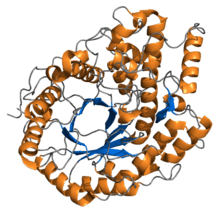Beta-amylase
Beta-amylase (EC 3.2.1.2, β-amylase, saccharogen amylase, glycogenase) is an enzyme with the systematic name 4-alpha-D-glucan maltohydrolase.[2][3][4] This enzyme catalyses the following chemical reaction:
- Hydrolysis of (1->4)-alpha-D-glucosidic linkages in polysaccharides so as to remove successive maltose units from the non-reducing ends of the chains.
| Beta-amylase | |||||||||
|---|---|---|---|---|---|---|---|---|---|
 | |||||||||
| Identifiers | |||||||||
| EC number | 3.2.1.2 | ||||||||
| CAS number | 9000-91-3 | ||||||||
| Databases | |||||||||
| IntEnz | IntEnz view | ||||||||
| BRENDA | BRENDA entry | ||||||||
| ExPASy | NiceZyme view | ||||||||
| KEGG | KEGG entry | ||||||||
| MetaCyc | metabolic pathway | ||||||||
| PRIAM | profile | ||||||||
| PDB structures | RCSB PDB PDBe PDBsum | ||||||||
| Gene Ontology | AmiGO / QuickGO | ||||||||
| |||||||||
This enzyme acts on starch, glycogen and related polysaccharides and oligosaccharides producing beta-maltose by an inversion. Beta-amylase is found in bacteria, fungi, and plants; bacteria and cereal sources are the most heat stable. Working from the non-reducing end, β-amylase catalyzes the hydrolysis of the second α-1,4 glycosidic bond, cleaving off two glucose units (maltose) at a time. During the ripening of fruit, β-amylase breaks starch into maltose, resulting in the sweet flavor of ripe fruit.
β-amylase is present in an inactive form prior to seed germination. Many microbes also produce amylase to degrade extracellular starches. Animal tissues do not contain β-amylase, although it may be present in microorganisms contained within the digestive tract. The optimum pH for β-amylase is 4.0–5.0[5] They belong to Glycoside hydrolase family 14.
See also
References
- Rejzek M, Stevenson CE, Southard AM, Stanley D, Denyer K, Smith AM, Naldrett MJ, Lawson DM, Field RA (March 2011). "Chemical genetics and cereal starch metabolism: structural basis of the non-covalent and covalent inhibition of barley β-amylase". Molecular BioSystems. 7 (3): 718–30. doi:10.1039/c0mb00204f. PMID 21085740.
- Balls AK, Walden MK, Thompson RR (March 1948). "A crystalline beta-amylase from sweet potatoes". The Journal of Biological Chemistry. 173 (1): 9–19. PMID 18902365.
- French D (1960). "β-Amylases". In Boyer PD, Lardy H, Myrbaumlck K (eds.). The Enzymes. 4 (2nd ed.). New York: Academic Press. pp. 345–368.
- Manners DJ (1962). "Enzymic synthesis and degradation of starch and glycogen". Advances in Carbohydrate Chemistry. 17: 371–430. doi:10.1016/s0096-5332(08)60139-3. ISBN 9780120072170.
- "Amylase, Alpha" , I.U.B.: 3.2.1.11,4-α-D-Glucan glucanohydrolase.
Further reading
- Balls AK, Walden MK, Thompson RR (March 1948). "A crystalline beta-amylase from sweet potatoes". The Journal of Biological Chemistry. 173 (1): 9–19. PMID 18902365.
- Manners DJ (January 1963). "Enzymic synthesis and degradation of starch and glycogen". Advances in Carbohydrate Chemistry. Academic Press. 17: 371–430.
- Manners DJ (1962). "Enzymic synthesis and degradation of starch and glycogen". Advances in Carbohydrate Chemistry. 17: 371–430. doi:10.1016/s0096-5332(08)60139-3. ISBN 9780120072170.
- Friedberg F, Rhodes C (March 1986). "Cloning and characterization of the beta-amylase gene from Bacillus polymyxa". Journal of Bacteriology. 165 (3): 819–24. doi:10.1128/JB.165.3.819-824.1986. PMC 214501. PMID 2419310.
- Rhodes C, Strasser J, Friedberg F (May 1987). "Sequence of an active fragment of B. polymyxa beta amylase". Nucleic Acids Research. 15 (9): 3934. doi:10.1093/nar/15.9.3934. PMC 340808. PMID 2438660.
External links
- {http://www.worthington-biochem.com/BA/default.html "Amylase, Alpha" , I.U.B.: 3.2.1.11,4-α-D-Glucan glucanohydrolase.] "Amylase, Alpha" , I.U.B.: 3.2.1.11,4-α-D-Glucan glucanohydrolase.
External links
- Beta-amylase at the US National Library of Medicine Medical Subject Headings (MeSH)